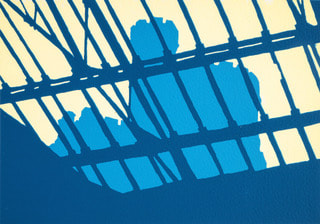Waverley Station by Ian Scott Massie
Reduction Screen Print - Edition of 8
16" x 12" Mounted size - 10" x 7" Image size
Available: unframed @ £130
To shop, please click here
16" x 12" Mounted size - 10" x 7" Image size
Available: unframed @ £130
To shop, please click here
WAVERLEY STATION
The end of the line for our journey is at a railway station which almost sits underground. 393 miles, 632 km from London, Waverley station lies in the shadow of Edinburgh’s old town in the space where the dark waters of the Nor Loch used to be.
The first railway line into Edinburgh, from Glasgow, stopped at Haymarket, partly because of local opposition to the lines going any further towards the centre. Then the North British Railway joined onto it with a connecting line to its new station at Waverley and later built a link to the north of England. The system was finally consolidated with the building of the Forth Bridge in 1890 creating a line all the way from Aberdeen to London.
The name Waverley derives from the writings of Walter Scott and the station is decorated with phrases from his writings. Scott was highly influential in creating the image we know so well of Scotland as a land of stirring myths, rich history and tartan. His status is reflected in the huge monument on Princes Street.
Waverley has a special place in my career as a painter. I was once busking on the steps leading down to the station. A short distance from me was a watercolour painter. I watched in awe at the speed with which he worked and, after a while, we both took a break for a chat. He’d been working in Spain and the heat had shortened the drying time of the paint, forcing him to work fast. He’d found that all kinds of effects were possible if you could work them into the paint rapidly before it dried.
I went away and set about speeding up my technique. I was amazed at the results I could achieve , the smoothness of washes, the directional drifts of colour I could produce. His advice has stayed with me ever since.
The first railway line into Edinburgh, from Glasgow, stopped at Haymarket, partly because of local opposition to the lines going any further towards the centre. Then the North British Railway joined onto it with a connecting line to its new station at Waverley and later built a link to the north of England. The system was finally consolidated with the building of the Forth Bridge in 1890 creating a line all the way from Aberdeen to London.
The name Waverley derives from the writings of Walter Scott and the station is decorated with phrases from his writings. Scott was highly influential in creating the image we know so well of Scotland as a land of stirring myths, rich history and tartan. His status is reflected in the huge monument on Princes Street.
Waverley has a special place in my career as a painter. I was once busking on the steps leading down to the station. A short distance from me was a watercolour painter. I watched in awe at the speed with which he worked and, after a while, we both took a break for a chat. He’d been working in Spain and the heat had shortened the drying time of the paint, forcing him to work fast. He’d found that all kinds of effects were possible if you could work them into the paint rapidly before it dried.
I went away and set about speeding up my technique. I was amazed at the results I could achieve , the smoothness of washes, the directional drifts of colour I could produce. His advice has stayed with me ever since.





